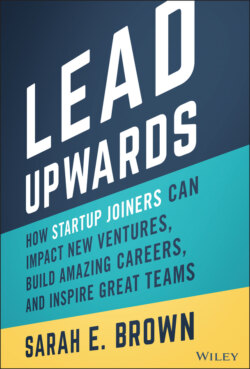Читать книгу Lead Upwards - Sarah E. Brown - Страница 36
FROM BIG COMPANY LEADER TO STARTUP EXECUTIVE: COO ERIN RAND'S STORY
ОглавлениеFor operations executive Erin Rand, COO of PlasticBank, her first executive role was at a larger organization and her first startup executive role came later. At the larger organization, a rapidly‐scaling company of thousands of employees, she described her first‐time executive experience as “getting my ticket punched.”
“The first time you're in an executive role is the hardest to make happen because it's the first person who's willing to take that chance on you,” says Rand. “Once you've had the title, everybody else sees you as that from then on.”
Rand was given her first executive role, which involved owning a business line with profit and loss (P&L), because she had proven herself successful as a manager and the mentors around her helped her succeed and believed in her ability to learn and grow into an executive role.
“One of the key things of being successful is having a close group of people around you who support your growth,” says Rand. “I had a group of people around me who were very generous with their support and their advice.”
Rand once had a global controller let her know she'd behaved in a meeting in a way that didn't land well. She would start meetings jumping right into the work without making small talk, which he said didn't align with the organization's mode of operating and culture.
“He told me to take time to connect with everybody who's in the room and have a human conversation,” says Rand. “I thought that we're all under this time pressure and how I'm being judged is what I get done, and people are expecting me to deliver results. I don't want to waste people's time.”
Rand's mentor helped her realize that leadership wasn't just about delivering results, but about establishing the relationships in the organization, building trust, not just in your own team, but your peers and others. Everybody wants to be seen.
By taking in feedback from mentors around her and applying it, she ended up being promoted to take over an organization of more than 80 people with tens of millions in revenue.
“The CEO didn't believe that I should be given the role because it was such a big jump for me,” says Rand. “I'd only ever led a single‐digit team, but my mentor convinced him I would perform.”
Rand's first executive role at a large company led her to become a startup executive, and she faced some of the growing pains discussed earlier of mapping her “big company” experience to a highly different startup culture. She says her friends and even some of her supporters at her larger company doubted her ability to successfully transition.
“You're like Ms. Corporate,” they told me. “Oh, you're going to hate it. You're not going to be good at it,” says Rand.
Rand ignored the naysayers and found a group of peers in Silicon Valley focused on women's empowerment in business who encouraged her to talk about her contributions rather than her role. When she met a startup founder who had an open operations leadership role, she was able to successfully describe how her experience at a big company would support his scaling startup.
“Instead of saying I was a senior director of global services, I would say, ‘I figure out how to build organizations that don't exist or break down and rebuild organizations that need to be rebuilt in a fast‐moving way.'”
Upon transitioning from big‐company executive to startup executive, Rand says it took time to “knock the corporate off (her).” Rand learned to integrate more of her personal life with her professional persona at a startup, becoming more vulnerable with her team, and even befriending them on social media. While acclimatization to startup culture required effort, she also found that her skills and “big company” knowledge were highly valuable in the startup environment and she found success by leaning on those early on.
She quickly found a home for her honed operations skills based on the startup's needs. Rand was very comfortable with board meetings and prep due to lots of early exposure at her large company.
“In my first leadership role at a startup, I saw what they were sharing with the board. I was like, ‘what the F‐‐‐ are you doing? This is a mess. How can this be what you're sharing with the board?”
Rand spent the week prior to her first board meeting re‐doing all of the company's materials, including the financials and reporting structure. The board was “very happy” with the results of her efforts, and that the founder had someone who could communicate in the way the board expected and who could structure the information in a way they could understand and give feedback on much more efficiently.
Rand says she had a “really firm wall” between her personal and professional lives. In her larger company environment, she learned it was “unprofessional” to blend the two. When she started getting social media invitations from her global team members at the startup, she was nervous. One of her direct reports told her they wanted to know her and for her to know them, and she took that feedback to heart.
“Now, I understand there's never anything more important than the people around you, so it doesn't matter what deadline you're on. If someone comes up to your desk and wants to talk, you just stop and you talk. You don't make them feel like you're rushed,” says Rand.
